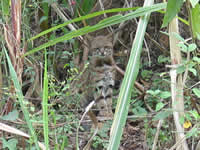
October 28, 2008
The photograph of the wild cat [above] was taken by Aldo Sornoza of Fundación Jocotoco (FJ), who was helping with the construction of the new visitors’ lodge on the Jorupe Reserve, Ecuador. It is thought to be a new species of cat, still to be described, which was first seen two years ago in Peru. The Jorupe Reserve, owned and managed by the World Land Trust’s partners FJ, is close to the border with Peru and this would be the first known sighting in Ecuador.
If the new mystery cat photograph does not show a new species, the only other cat it could possibly be is an Andean Cat (Oreailurus jacobita), one of the rarest of all the cat species, about which very little is known. Over the last 25 years there have been fewer than 10 documented sightings of Oreailurus jacobita.
The Andean Mountain Cat (Oreailurus jacobita, Leopardus jacobitus or L. jacobita) is also known as the Andean Cat. Its habitat and appearance make it the small cat analogue of the Snow Leopard. While it is only about the size of a domestic cat, it appears larger because of its long tail and silvery-gray, striped and spotted long fur. The body length is about 60 cm (24 in), the tail length is 42 cm (17 in), the shoulder height is 36 cm (14 in) and the body weight is 5.5 kg (12 lbs).
The Andean Cat is one of the least known and rarest of all felines; almost all that is known about it comes from a few observations in the wild and from skins. There are none in captivity. It is believed to live only in the high Andes mountains of Peru, Bolivia, Chile, and Argentina. They are not known to exist in Ecuador. It has been sighted at elevations of 5,100 meters, well above the tree line.
Lou Jost, of Fundación EcoMinga, also an Ecuadorian partner of the WLT, is lucky enough to have seen the Andean Cat, not just once but twice. When presented with the mystery cat photo, Lou commented:
“The ground color is very similar [to that of the Andean Cat]. However I didn’t see any strong patterns on the legs, like this one has, though I would not have seen that from the angles I had (just the back and sides of the animal running through dense vegetation, both times). The elevations of my sightings were very high, around 2800-3000 m, and very wet, completely different from Jorupe. I could easily imagine that there is a new species of cat endemic to the Tumbesian zone of SW Ecuador and NW Peru.”
Sources: World Land Trust; Wozencraft, W. C. in Wilson, D. E., and Reeder, D. M. (eds): Mammal Species of the World, 2005, Johns Hopkins University Press, 538; Cat Specialist Group (2002), Oreailurus jacobita. 2006 IUCN Red List of Threatened Species.
++++
Update: Solved – Is it a Pampas Cat? Leopardus pajeros garieppi is found in Peru, Ecuador, and Bolivia.
About Loren Coleman
Loren Coleman is one of the world’s leading cryptozoologists, some say “the” leading living cryptozoologist. Certainly, he is acknowledged as the current living American researcher and writer who has most popularized cryptozoology in the late 20th and early 21st centuries.
Starting his fieldwork and investigations in 1960, after traveling and trekking extensively in pursuit of cryptozoological mysteries, Coleman began writing to share his experiences in 1969. An honorary member of Ivan T. Sanderson’s Society for the Investigation of the Unexplained in the 1970s, Coleman has been bestowed with similar honorary memberships of the North Idaho College Cryptozoology Club in 1983, and in subsequent years, that of the British Columbia Scientific Cryptozoology Club, CryptoSafari International, and other international organizations. He was also a Life Member and Benefactor of the International Society of Cryptozoology (now-defunct).
Loren Coleman’s daily blog, as a member of the Cryptomundo Team, served as an ongoing avenue of communication for the ever-growing body of cryptozoo news from 2005 through 2013. He returned as an infrequent contributor beginning Halloween week of 2015.
Coleman is the founder in 2003, and current director of the International Cryptozoology Museum in Portland, Maine.
Filed under Alien Big Cats, Breaking News, Cryptotourism, CryptoZoo News, Cryptozoologists, Cryptozoology, Evidence, Mystery Cats, New Species, Photos